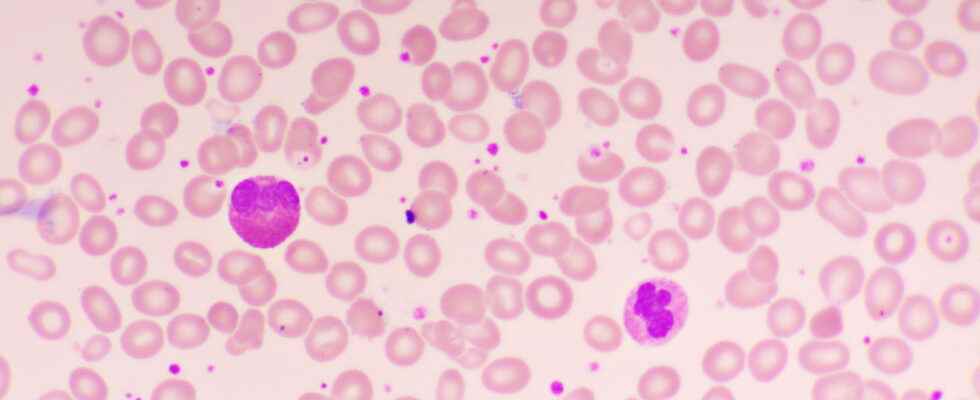Thrombocytosis (hyperplatelettosis) is a blood disorder that results in an abnormal elevation of blood platelets. What diseases cause platelets to rise? The cancer ? Is that bad ?
Definition: what is thrombocytosis?
Thrombocytosis (also called hyperplatelettosis) corresponds to an increase in the number of platelets in the blood. The norm of the level of blood platelets being between 150 and 400 G/L of blood, We are talking about thrombocytosis when it exceeds 450 G/L.
What are the possible causes of thrombocytosis?
There are several etiologies for thrombocytosis:
- it can be exceptionally familial
- it can be reactive to inflammation
- it may be due to a iron deficiency (in 90% of cases)
- it can be associated with a disease of the bone marrow that makes platelets. This is called essential thrombocythemia. “This is rare and corresponds to a lasting elevation of the platelets. Mutations are often observed. It corresponds to a myeloproliferative syndrome“adds Dr. Sylvain Choquet, hematologist at Pitié-Salpêtrière.
Reactive thrombocytosis can appear in certain contexts: stress, heavy physical exertion. Certain diseases can also cause thrombocytosis, such as bacterial infections (25% of thrombocytosis), the inflammatory joint diseases such as chronic polyarthritis or the intestine: ulcerative colitis (UCH)… or even the cancers.
What are the symptoms of thrombocytosis?
“Most of the time, there are no symptoms, especially if the thrombocytosis is moderate,” replies our interlocutor. Platelets play an important role in coagulation. If they are very high ( ≥ 1 million platelets in the blood – the norm is 150,000 to 400,000/mm3), they are very often linked to essential thrombocythemia or related illnesses, and rarely to reaction situations. When there are too many, as in essential thrombocythemia, there is a risk in the short term above all of seeing form blood clots in the vesselsclots that can migrate and clog an artery in the brain, for example, causing thrombosis, pulmonary embolism or cerebrovascular accident (CVA)… This high elevation of platelets can also cause bleeding.
What does the blood test performed to diagnose thrombocytosis consist of?
When a patient arrives in consultation with high platelets following a blood test, a clinical examination must be carried out:
► If you notice a large spleenthe diagnosis will quickly be oriented towards essential thrombocythemia or another hematological disease.
► If the examination finds nothing in particularthe most frequent causes will first be eliminated, especially if it is a person who is not very old: an inflammatory assessment and a martial assessment will be carried out.
► If they are negative, “the search for mutations (Jak2, MPL and CALR) will be requested in order to consider essential thrombocythemia. A bone marrow biopsy, recommended by the World Health Organization (WHO), can then confirm the diagnosis: fibrosis and anomalies which correspond to an abnormal proliferation of platelet precursors, megakaryocytes”says Dr. Choquet.
Is thrombocytosis serious and can you die from it?
Depending on the forms of thrombocytosis, this pathology is more or less serious. Essential thrombocythemia, which is one of the severe forms of thrombocytosis, is one of the myeloproliferative syndromes, “and remains the one who is the least bad“. The problem is essentially if the diagnosis is not made or too late: the patient may die of pulmonary embolism, cerebral hemorrhage or another thrombotic or hemorrhagic phenomenon, a consequence of thrombocytosis. “This is what makes gravity: very rarely, this disease turns into acute leukemia”, he insists.
What to do: what treatment to treat thrombocytosis?
The management of thrombocytosis depends on its origin and its symptoms. “For example, a young patient, who has less than 1 million platelets due to essential thrombocythemia – and who has no risk factors for thrombosis, will be monitored without treatment. While an elderly person, who has a higher risk of thrombosis, will be treated“, explains Dr. Choquet. Regular follow-up will be set up with a hematologist. The implementation of drug treatment is usually offered by hydroxyurea to balance the platelet concentration.
Thanks to Dr Sylvain Choquet, hematologist at Pitié-Salpêtrière (Paris)
